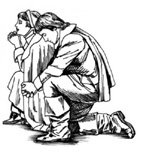
On Bending the Knee to Receive Holy Communion
TO KNEEL BEFORE THE HOLY IS NOT HOLIER-THAN-THOU
The Catholic Church teaches that “In the most Blessed Sacrament of the Eucharist ‘the body and blood, together with the soul and divinity, of our Lord Jesus Christ and, therefore, the whole Christ is truly, really and substantially contained'” (Catechism of the Catholic Church, no. 1374). For, after the priest says the words of consecration at Mass, there is a change of the “whole substance of the bread into substance of the Body of Christ our Lord and of the whole substance of the wine into His Blood” (Catechism, no. 1376). So, the physical element, or physical Eucharistic Host, which remains after the consecration, is no longer physical bread. After the consecration, it is the “whole Christ.” It is His Divine Person and Being!
This is why the Sacred Congregation for the Discipline of the Sacraments stated toward the end of their January 25, 1973, document Immensae Caritatis that “It is necessary to instruct the faithful that Jesus Christ is Lord and Savior and that the same worship and adoration given to God is owed to Him present under the sacramental signs.” So, “adoration” is “owed” to the Blessed Sacrament! Thus, a number of Catholics today genuflect in adoration to the Blessed Sacrament immediately prior to receiving Holy Communion in Roman Rite Catholic churches. These Catholics feel the urge to genuflect all the more if there is a delay (e.g., if they have to wait for five minutes) between their kneeling in adoration at “Behold the Lamb of God…” and the moment when they receive Holy Communion.
Some priests, however, appear thoroughly outraged by such a devotional gesture and sternly — even hysterically — object. They believe that this genuflecting is overdoing Eucharistic devotion and they often accuse these genuflecting Catholics of pretending to be “holier than thou.” Others express concern that someone might trip over the person making a genuflection. Some pastors try to solve the difficulty by telling Catholics to replace the genuflection with a bow or a sign of the cross.
So what should be done? Should a Catholic make a sign of reverence prior to Holy Communion or not? And if he should, should it be a sign of adoration? And if yes, then what is the act of adoration in the Roman Rite that one should make? Let’s investigate.
You May Also Enjoy
A renewal of the Lord’s Day would have us finding so many things worth doing for their own sake that we couldn’t be bothered to do ordinary, non-spiritual work.
Why do Catholics (and Jews) reject prostration as a regular posture of liturgical worship, and why do Muslims use it as the signature posture of daily salat?
After attending various Masses and talking with parishioners, we came to the conclusion that parish success or decline depends on the homily of the pastor.

